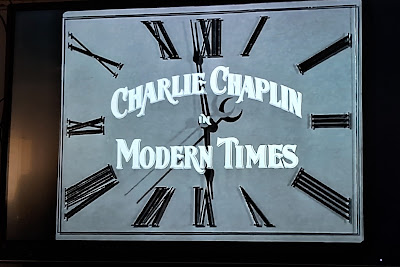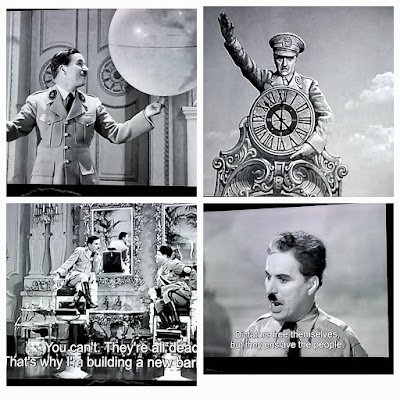Zeitgeist of the Time: Modern Times and The Great Dictator
Activity: Frame Study of Modern Times and The Great Dictator
This blog is part of task given by Dilipsir Barad(Click Here ) As part of the background study for 20th Century Literature
The Morden Times
Modern Times is a 1936 American part-talkie comedy film produced, written and directed by Charlie Chaplin. In Chaplin's last performance as the iconic Little Tramp, his character struggles to survive in the modern, industrialized world. The film also stars Paulette Goddard, Henry Bergman, Tiny Sandford and Chester Conklin.

Modern Times has won many awards and honors, and is widely considered one of the greatest films ever. It was one of the first 25 films selected by the Library of Congress for preservation in the National Film Registry for being "culturally, historically, or aesthetically significant".
Fram study :

The scenes in this image montage appear to reflect themes of industrialization, mechanization, and centralized authority. The prominent figure displayed in the portraits suggests a hierarchical or dystopian narrative, where the individual's presence may symbolize control or leadership. The machinery and control panels evoke a mid-20th-century fascination with industrial progress, potentially serving as commentary on the loss of human individuality in mechanized environments.

The sequence features Chaplin’s iconic character, the Tramp, interacting with a comical and exaggerated piece of industrial machinery—a feeding machine intended to improve efficiency in the workplace.
The feeding machine malfunctions, leading to chaos and absurdity, which aligns with the film's satire of industrialization and the dehumanization of workers during the Machine Age. This scene is a critical commentary on the obsession with productivity and technological innovation at the expense of human dignity and practicality. It masterfully blends humor with social critique, making it one of the most memorable moments in cinematic history.

The top-left image is likely from a scene where Chaplin's character, the Tramp, meets a woman in a rural setting.
The top-right image shows the Tramp amidst a crowd, possibly depicting the chaos of the industrial workforce.
The bottom-left features a scene where Chaplin's character is at a factory gate, where the Tramp tries to navigate the struggles of gaining employment.
The bottom-right might be a moment in the film where the Tramp encounters authority figures, reflecting the struggle between workers and management.
Conclusion :
The film masterfully blends comedy and social commentary, with memorable scenes like the Tramp being swallowed by giant machinery, symbolizing the alienation and exploitation caused by industrial systems. Despite the hardships depicted, Modern Times ends on a hopeful note, emphasizing resilience and optimism.
This film remains timeless, reminding viewers of the need for balance between progress and humanity and the enduring value of kindness and perseverance in the face of adversity. It’s a cinematic masterpiece that continues to resonate across generations.
The Great Dictator:
The Great Dictator is a 1940 American political satire black comedy film written, directed, produced by, and starring, British filmmaker Charlie Chaplin. Having been the only Hollywood filmmaker to continue to make silent films well into the period of sound films, Chaplin made this his first true sound film. ( click here )
Frame Study:

The movie is a powerful satire of fascism, specifically targeting Adolf Hitler, Nazi Germany, and totalitarian regimes.
Top-left: Likely depicts Chaplin's exaggerated military technology, reflecting the absurdity of war and the futility of the arms race.
Top-right: Shows soldiers in a trench during a comedic moment, mocking the rigid military discipline and absurdities of war.
Bottom: A scene in the aftermath of destruction, representing the tragic consequences of war, balanced with Chaplin's characteristic humor.

The headlines convey key events in the fictional country of Tomania, parodying the rise of fascism and authoritarian regimes, particularly Nazi Germany.
"Peace!": Likely signifies the end of World War I, setting the stage for the events to follow.
"Dempsey Beats Willard!" and "Lindbergh Flies Atlantic!": These headlines reference real-world events to provide a historical context for the timeline of Tomania's development.
"Hynkel Party Takes Power!": This is a pivotal moment, showing Adenoid Hynkel (a parody of Adolf Hitler) and his fascist party seizing control, mirroring the rise of Nazism.
"Riots in Tomania!": Reflects the unrest and chaos under Hynkel’s regime, highlighting the oppression and discontent of the populace.

1. Top-left: Adenoid Hynkel delivering a speech, mocking authoritarian rhetoric with absurdities like "Liberty is odious."
2. Top-right: Hynkel with a child, parodying propaganda efforts to appear benevolent.
3. Bottom-left: A scene glorifying Hynkel’s regime with statues and banners, symbolizing the cult of personality.
4. Bottom-right: A stormtrooper painting "Jew" on a shop, highlighting anti-Semitic oppression.

1. Top-left: Hynkel playing with the globe balloon – a symbolic and satirical scene showing his delusions of world domination. It humorously portrays the fragility and vanity of his ambitions.
2. Top-right: Hynkel standing atop a clock, performing a fascist salute. This may symbolize the dictator’s control over time and history or his attempt to immortalize his regime.
3. Bottom-left: A humorous interaction between Hynkel and his ally, Napaloni (a parody of Mussolini). Their rivalry is depicted as childish, ridiculing the egos of fascist leaders.
4. Bottom-right: The Jewish barber’s final speech, contrasting with Hynkel’s rhetoric. He condemns dictators for enslaving people while pleading for unity, freedom, and democracy.
Conclusion:
The Great Dictator is both a brilliant comedy and a profound social commentary. Chaplin uses humor to expose the absurdity and danger of totalitarian regimes while delivering a heartfelt message of hope and compassion. The final speech is one of the most memorable moments in film history, standing as a timeless call for peace and humanity.
References:
---. “The Great Dictator.” Wikipedia, 22 Dec. 2024, en.m.wikipedia.org/wiki/The_Great_Dictator.The_Great_Dictator.
Wikipedia contributors. “Modern Times (film).” Wikipedia, 23 Dec. 2024, en.m.wikipedia.org/wiki/Modern_Times_(film).

Comments
Post a Comment